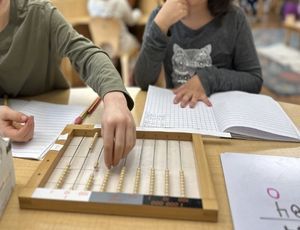Dr. Maria Montessori consistently emphasized the importance of following the child. This means that we must recognize that each child has her own pattern and instinctively knows what she needs. However, does this apply to motor development too? Of course. In this month's article, we will look into the most common mistakes adults make while trying to help their child’s motor development, and how to support them better without interfering with their natural development.
Movement is one of the most critical aspects of your child's development. The progress of the acquisition of voluntary movements takes around twelve months. The newborn goes from an almost a complete lack of coordination to the most challenging form of coordination: walking on two legs. This skill requires a very sophisticated system of balance.
The development of movement unfolds naturally if we allow babies to move freely according to their inner schedules. When you foster this, they will naturally learn how to move with ease and grace. Usually, children that have experience with natural freedom of movement tend to have excellent body awareness and posture, and have an accurate sense of where their bodies are in space.
Something that we must always keep in mind is that we should avoid placing babies into a position they can’t get into or out of on their own. We must protect the natural unfolding of their gross motor development. Remember, it will take about one year for your child to have sophisticated gross motor skills. Movement requires the coordination of three systems: skeletal, muscular, and nervous; so, every new move she coordinates comes after a great work that does not happen suddenly. It takes time and practice and everything should be at her own pace.
Tummy Time
It is very common to hear parents say, “My baby does not like tummy time.” Well, that is entirely true, but have we ever thought about why? Let’s do it now. Imagine somebody put you on your stomach, lying on the ground. You want to lift your head, use your shoulders and roll over, but wait; your body cannot do this yet, so, you are stuck in that position until somebody moves you. How would you feel? The odds are you will be irritated, confused, tired, and anxious. Well, this happens to babies every time they are placed on “tummy time” without being able to roll over. So, what should be done? Observation is the answer. Observe your infant and notice when she starts to roll by herself. This means that her back extensors are strong enough now, and she will be able to put herself on her tummy and get out of that position when she wants to. Remember that this process takes months.
A Seated Infant
In order for an infant to sit without any help she needs to have strong back muscles and balance. There is no need to prop up infants with multiple pillows around them to make them sit. If their body is not ready for this position yet, this can be detrimental to development. Their back and neck will be forced to support the weight of their body without having the muscular tone.
“Walking” a Baby
For many adults, it is very tempting to hold the arms of a baby that is pulling up from furniture and “help” her walk. Usually, the adult “walks” her, and many times the feet of the baby might not even be touching the floor completely. Many babies seem to be entertained by it, but is it beneficial? Is the adult truly teaching her how to walk? The answer is no. Only babies know how their body is best positioned and when to do it. By holding their arms, we are hindering their natural ability to find balance, sense spatial relations, and judge what they can or cannot do. Plus, babies will get a false sense of their balance and their inner abilities. The baby will think she can walk, and it can be dangerous since she might try to walk down the steps and get the immediate feedback that in reality, she does not know how to walk yet, and in fact it was the adult who knew how to “walk” her.
Psychological Impact
When we rush the development of a baby, there is a psychological connotation that is not often considered. We are giving the message to the baby that what she is doing right now is simply not enough. Babies need to know they are enjoyed and loved for what they can do at this moment. Our interference only confuses the process, and in many ways, corrupts it.
So, let’s relax, knowing that their unique inborn timetable leads each infant’s development. They will do what they are capable of doing.
Item of the Month
Pull-up Bar and Mirror: It is a wooden bar safely secured to the wall that enables the baby to pull up and cruise. It should be at least one inch from the wall to allow the hand of the child to wrap around the bar; the height of the bar should be at the chest of the child. It is also suggested to mount a mirror behind the bar on the wall so the child can have visual feedback of her movements.
Link to buy it at Amazon: https://www.amazon.com/-/es/Jonti-Craft-0619JC-espejo-coordinaci%C3%B3n-infantil/dp/B000RZQDGI/ref=sr_1_2?__mk_es_US=%C3%85M%C3%85%C5%BD%C3%95%C3%91&keywords=Montessori+MIrror+pull+up+bar&qid=1581611775&sr=8-2
Quote of the Month
“Follow the child, they will show you what they need to do, what they need to develop in themselves and what area they need to be challenged in. The aim of the children who persevere in their work with an object is certainly not to learn; they are drawn to it by the needs of their inner life, which must be recognized and developed by its means.”
-Maria Montessori
Video of the Month
Rolling – Feldenkrais with Baby Liv
This 3:20 minute video will take you through the natural development of motor skills of Baby Liv. You will observe the progression and how she does it by herself through many repetitions and freedom of movement. It took a year to film the video, which reminds us that each milestone takes time, and a baby knows herself better than anybody else.
Here is the link, enjoy!
https://www.youtube.com/watch?v=D9Ko7U1pLlg



